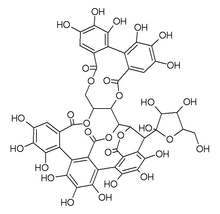
| |
| Identifiers | |
|---|---|
3D model (JSmol)
|
|
PubChem CID
|
|
CompTox Dashboard (EPA)
|
|
| |
| Properties | |
| C46H34O30 | |
| Molar mass | 1066.748 g·mol−1 |
Except where otherwise noted, data are given for materials in their standard state (at 25 °C [77 °F], 100 kPa).
| |
Grandinin is an ellagitannin. It can be found in Melaleuca quinquenervia leaves[1] and in oaks species like the North American white oak (Quercus alba) and European red oak (Quercus robur).[2] It shows antioxydant activity.[1] It is an astringent compound.[3] It is also found in wine, red[4] or white,[5] aged in oak barrels.
It is a castalagin glycoside[6] by binding of the pentose lyxose.[3] It contains a nonahydroxytriphenic acid moiety.
It suppresses the phosphorylation of the epidermal growth factor receptor in human colon carcinoma cells.[6]
- ^ a b Moharram, F. A.; Marzouk, M. S.; El-Toumy, S. A. A.; Ahmed, A. A. E.; Aboutabl, E. A. (2003). "Polyphenols of Melaleuca quinquenervia leaves – pharmacological studies of grandinin". Phytotherapy Research. 17 (7): 767–773. doi:10.1002/ptr.1214. PMID 12916075.
- ^ Mämmelä, P.; Savolainen, H.; Lindroos, L.; Kangas, J.; Vartiainen, T. (2000). "Analysis of oak tannins by liquid chromatography-electrospray ionisation mass spectrometry". Journal of Chromatography A. 891 (1): 75–83. doi:10.1016/S0021-9673(00)00624-5. PMID 10999626.
- ^ a b Hofmann, T.; Glabasnia, A.; Schwarz, B.; Wisman, K. N.; Gangwer, K. A.; Hagerman, A. E. (2006). "Protein Binding and Astringent Taste of a Polymeric Procyanidin, 1,2,3,4,6-Penta-O-galloyl-β-d-glucopyranose, Castalagin, and Grandinin". Journal of Agricultural and Food Chemistry. 54 (25): 9503–9509. doi:10.1021/jf062272c. PMC 2597504. PMID 17147439.
- ^ García-Estévez, I.; Escribano-Bailón, M. T.; Rivas-Gonzalo, J. N. C.; Alcalde-Eon, C. (2010). "Development of a fractionation method for the detection and identification of oak ellagitannins in red wines". Analytica Chimica Acta. 660 (1–2): 171–176. Bibcode:2010AcAC..660..171G. doi:10.1016/j.aca.2009.10.020. hdl:10366/141103. PMID 20103159.
- ^ Marinov, M. G.; Dimitrova, E. D.; Puech, J. -L. (1997). "Kinetics of ellagitannin extraction from oak wood using white wine". Journal of Wine Research. 8: 29–40. doi:10.1080/09571269708718095.
- ^ a b Fridrich, D.; Glabasnia, A.; Fritz, J.; Esselen, M.; Pahlke, G.; Hofmann, T.; Marko, D. (2008). "Oak Ellagitannins Suppress the Phosphorylation of the Epidermal Growth Factor Receptor in Human Colon Carcinoma Cells". Journal of Agricultural and Food Chemistry. 56 (9): 3010–3015. doi:10.1021/jf073427z. PMID 18419129., INIST 20325664